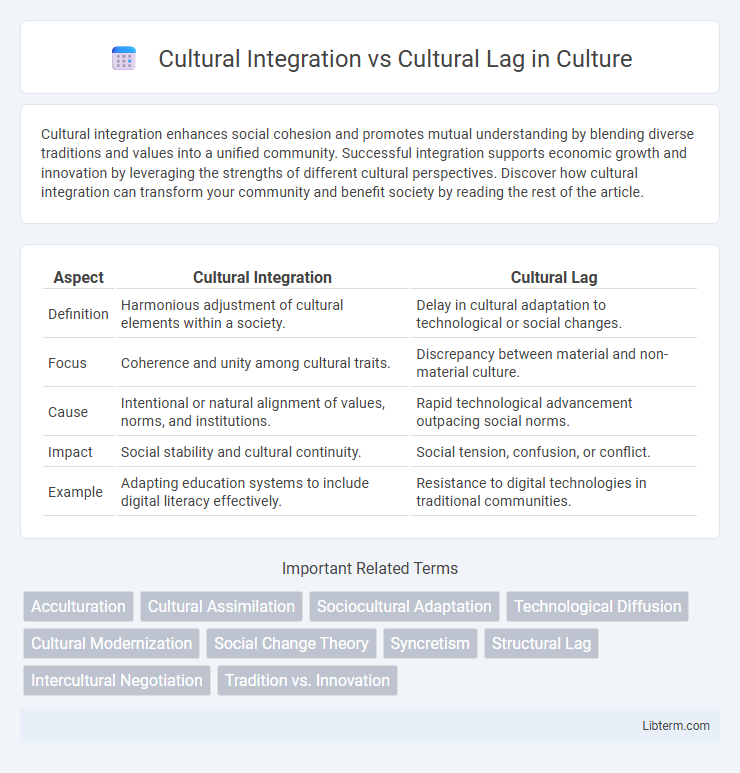Cultural integration enhances social cohesion and promotes mutual understanding by blending diverse traditions and values into a unified community. Successful integration supports economic growth and innovation by leveraging the strengths of different cultural perspectives. Discover how cultural integration can transform your community and benefit society by reading the rest of the article.
Table of Comparison
| Aspect | Cultural Integration | Cultural Lag |
|---|---|---|
| Definition | Harmonious adjustment of cultural elements within a society. | Delay in cultural adaptation to technological or social changes. |
| Focus | Coherence and unity among cultural traits. | Discrepancy between material and non-material culture. |
| Cause | Intentional or natural alignment of values, norms, and institutions. | Rapid technological advancement outpacing social norms. |
| Impact | Social stability and cultural continuity. | Social tension, confusion, or conflict. |
| Example | Adapting education systems to include digital literacy effectively. | Resistance to digital technologies in traditional communities. |
Defining Cultural Integration and Cultural Lag
Cultural integration refers to the process by which different cultural groups or social elements harmonize their values, norms, and behaviors to create a cohesive social system. Cultural lag describes the time delay that occurs when non-material culture, such as beliefs and institutions, struggles to adapt to changes in material culture, like technology and economic shifts. This gap often results in social conflicts or resistance as society adjusts to innovation and modernization.
Historical Perspectives on Cultural Change
Historical perspectives on cultural change reveal that cultural integration occurs when different cultural elements merge seamlessly, fostering social cohesion and innovation. In contrast, cultural lag describes the period during which material culture evolves faster than non-material aspects like beliefs and norms, causing conflicts and societal adjustment challenges. Classic examples include the Industrial Revolution, where technological advancements outpaced legal and ethical frameworks, highlighting the tensions between rapid material progress and slower cultural adaptation.
Key Drivers of Cultural Integration
Key drivers of cultural integration include technological advancements, globalization, and increased cross-cultural communication, which facilitate the blending of diverse cultural practices and values. Economic interdependence and organizational collaboration also promote cultural integration by encouraging shared norms and collective problem-solving approaches. These elements accelerate adaptation processes and reduce resistance to change within societies and institutions.
Causes and Manifestations of Cultural Lag
Cultural lag occurs when technological advancements outpace the social norms, values, and institutions needed to adapt, causing a delay in cultural integration. This phenomenon is often caused by resistance to change, lack of awareness, or institutional inertia, leading to disparities between material culture and non-material culture. Manifestations of cultural lag include legal ambiguities, social conflicts, and ethical dilemmas that arise as society struggles to reconcile new technologies with existing cultural frameworks.
The Role of Technology in Cultural Evolution
Technology acts as a catalyst in cultural integration by enabling faster communication, exchange of ideas, and blending of diverse cultural practices across global communities. However, cultural lag occurs when social norms, laws, and values struggle to adapt to rapid technological advancements, causing friction and delays in societal acceptance. The dynamic interplay between technological innovation and cultural adaptation shapes the pace and direction of cultural evolution in modern societies.
Social Institutions and Adaptation Processes
Cultural integration occurs when social institutions such as education, government, and family successfully adapt to emerging cultural norms, promoting societal cohesion and stability. In contrast, cultural lag happens when these institutions fail to keep pace with technological or ideological changes, causing tension and dysfunction within society. Effective adaptation processes within social institutions are essential to minimizing cultural lag and ensuring smooth transitions during cultural shifts.
Challenges and Consequences of Cultural Lag
Cultural lag occurs when technological advancements outpace societal adaptation, creating challenges such as social disorientation, value conflicts, and institutional inefficiencies. This phenomenon often leads to a disconnect between emerging innovations and established cultural norms, resulting in resistance, misunderstanding, and increased social tensions. The consequences of cultural lag include slowed social progress, exacerbated inequality, and difficulties in policy development aimed at effectively managing technological change.
Case Studies: Successful Examples of Cultural Integration
Case studies of successful cultural integration highlight organizations like Google, which fosters inclusive work environments by blending diverse cultural values and promoting collaboration through adaptive management strategies. Multinational corporations such as Unilever demonstrate effective cultural integration by implementing localized marketing campaigns that respect regional traditions while maintaining global brand consistency. These examples underscore how aligning organizational practices with cultural nuances reduces cultural lag, enabling seamless adoption of innovations across varied cultural contexts.
Policy Strategies to Bridge Cultural Lag
Policy strategies to bridge cultural lag emphasize proactive education and inclusive communication, promoting awareness of emerging technologies and social changes. Implementing adaptive regulations that reflect current societal values helps synchronize legal frameworks with technological advancements. Encouraging community participation in policymaking ensures that cultural integration evolves alongside innovation, minimizing resistance and fostering cohesive societal progress.
Future Trends in Cultural Adaptation and Integration
Future trends in cultural adaptation emphasize accelerated cultural integration driven by digital globalization, enabling faster exchange and acceptance of diverse values and practices. Advanced technologies and increased migration will reduce cultural lag by promoting real-time cultural adjustments within societies. Predictive analytics and AI tools will enhance understanding of cultural shifts, facilitating proactive integration strategies that minimize cultural lag effects.
Cultural Integration Infographic

 libterm.com
libterm.com